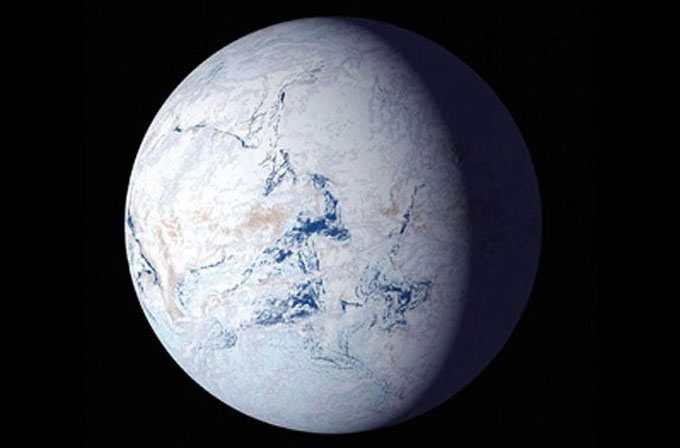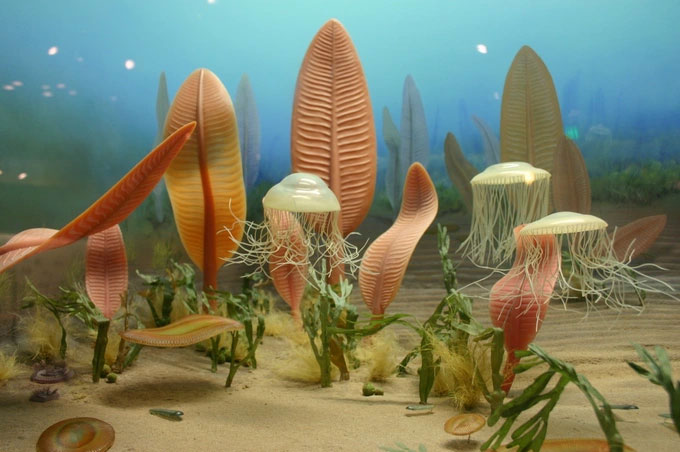During the Ediacaran period, life emerged. Two major extinction events wiped out the organisms of this era, but they may have paved the way for the evolution of many animal species.

Before the first emergence of life, Earth was just a giant snowball. (Illustration: Chris Butle).
About 650 million years ago, Earth was nearly completely frozen. According to the Snowball Earth hypothesis, the warming of our atmosphere and planet heralded the beginning of the Ediacaran period (Late Neoproterozoic), leading to the widespread emergence of multicellular life across the planet.
What Happened?
Over time, life evolved into more complex multicellular organisms.
Most Ediacaran biota lacked complex structures and mobility; they lived and remained in one location, tending to develop tubular and leaf-like forms while anchoring themselves to the ocean floor. Meanwhile, other life forms, like worms, were also immobile.
Some studies suggest that the organisms of this period absorbed nutrients through their skin.

Illustration of life in the Ediacaran biota. (Image: Ryan Somma).
Earth at this time was vastly different from today. For the first time, a supercontinent named Pannotia formed and broke apart, and the oceans (including areas deeper than today) were rich in oxygen.
Over time, life became increasingly complex and spread throughout the world. However, something triggered a mass extinction that caused these biotic communities to disappear!
Dr. Scott Evans from the Department of Geological Sciences at Virginia Tech explained in a paper: “The sudden drop in oxygen levels may have been the cause of this mass extinction.”
Additionally, other studies indicate that the life forms themselves contributed to the extinction that ended the Ediacaran period.
They argue that as new life forms developed, their different modes of operation led to fundamental changes in the ecosystem.

Crabs and other life forms in the Cambrian period (after the Ediacaran ended), which led to the rapid evolution of terrestrial animals. (Illustration: Smithsonian).
Proponents of this research argue that the life forms of the Cambrian biota (after the Ediacaran) were mobile and consumed the organisms of the Ediacaran period, leading to extinction.
However, Evans and his colleagues have disputed this, asserting that the sharp decline in oxygen levels was the primary cause.
He explained that the high density of organisms on Earth during this period was related to the global decline in oxygen levels. Our collected data indicate that environmental changes led to the decline in biodiversity during the Ediacaran, similar to other mass extinction events recorded in the geological record.
It is noteworthy that two mass extinctions occurred during the Ediacaran, spaced about 10 million years apart. The first was the White Sea-Nama mass extinction, which led to a sudden loss of biodiversity, and the second occurred at the boundary between the Ediacaran and Cambrian periods.
Why Did Oxygen Levels Decline?
Dr. Evans stated: “The ultimate causes of this mass extinction stem from multiple influences such as large volcanic eruptions, geological tectonic changes leading to shifts in oxidation-reduction states, temperature, or pH levels in the oceans. This resulted in a decline in biodiversity.”
Scientists have found a range of fossil organisms affected by the White Sea-Nama mass extinction that aligns with the predicted impacts of the disturbed environment of the Ediacaran period.
“Essentially, this extinction may have paved the way for the evolution of animals as we know them,” Evans added.
Subsequently, after the Ediacaran period came the Cambrian period, often referred to by scientists as the “Cambrian Explosion”, during which all modern animal phyla first appeared and continued to evolve to this day.
The early life of our planet faced catastrophic mass extinctions.
In modern times, Earth remains constantly threatened by meteors or comets from space and climate change, leading to numerous disasters such as superstorms, floods, record heat, and wildfires that occurred last summer in Europe, the U.S., and Pakistan, resulting in thousands of deaths.


















































